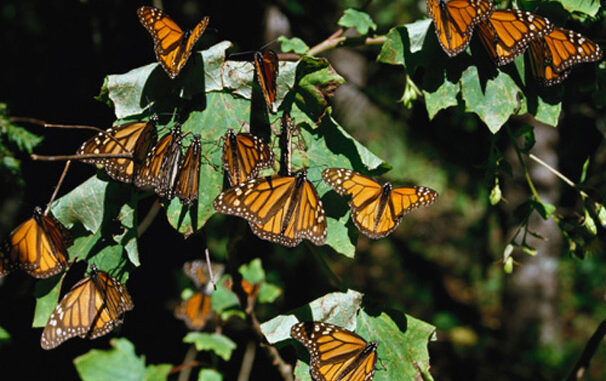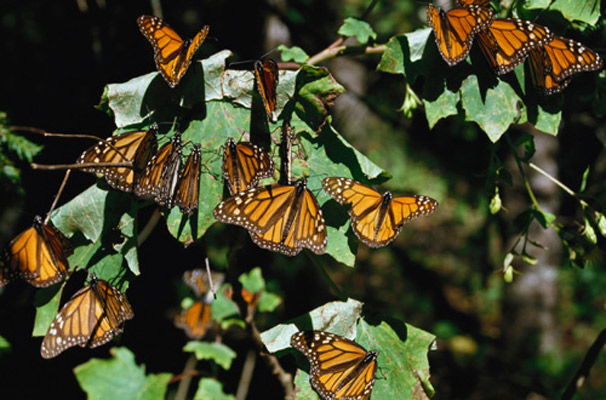

Sexto Sol/Photodisc/Getty Images
Monarchs in Mexico
Did you know that birds aren’t the only creatures that fly south for the winter? Monarch butterflies—up to 300 million each year—migrate up to 3,000 miles from Canada and North America to central Mexico for the winter months. They fly as high as 11,000 feet for 6 to 8 hours a day, often covering more than 100 miles in one day. The total trip takes from one to two months, depending on weather and other factors.
It is fascinating that monarch butterflies are the only type of butterfly to participate in these mass migrations, and not even all monarchs do. Only the monarchs born in the north in early fall migrate south. This special generation has a life span of six to nine months, as opposed to a life span of six to eight weeks for monarchs born in spring and early summer. The same butterflies head north again in early spring and lay their eggs on the way. As if they were in a relay race, the newly born butterflies continue the journey north, arriving in May or June. One of nature’s greatest mysteries is how these butterflies travel thousands of miles south and know where to go when they have never been there before! How would you explain this phenomenon? Some scientists believe that there must be an inherited behavior pattern.
So, where exactly do these butterflies go in Mexico? Their journey takes them to forests in the mountains west of Mexico City, in the states of Michoacán and México. The sanctuaries in this area, designated as The Monarch Butterfly Biosphere Reserve, with their dense forests of oyamel fir trees, provide an ideal habitat for the butterflies. The thick canopy protects them from sudden changes in temperature, strong winds, and heavy storms. The ground is brimming with nectar-filled flowers, milkweed (the only plant that monarchs eat), and dew and creeks for water. Some of these sanctuaries, such as El Rosario and Sierra Chincua, are open to the public. Wouldn’t you love to observe the spectacular sight of thousands of butterflies, so thick on tree branches that sometimes the branches break? Or the incredible view of thousands of beautiful orange and black butterflies gliding gracefully through the sky?
Unfortunately, the oyamel forest ecosystem, which is crucial to the survival of monarch butterflies, is being endangered by logging practices. Without a dense canopy to act as an umbrella and blanket to protect the butterflies from severe weather, the butterflies have less chance of survival. Joint efforts by the Mexican government and environmental groups are underway to restore the habitat. It is a difficult problem because the people living in the area depend on logging for their livelihood. The Mexican government offers them compensation for not logging, but it amounts to far less than they can earn by logging. A solution needs to be found that will allow the people and the butterflies to coexist.
Explore More:
1. Investigate the mystery of how monarch butterflies travel to the same place each year, even though they are generations removed from the last butterflies that made the trip. Discuss the different theories with your classmates and come to a conclusion about which theory you think makes the most sense.
2. Research other species of animals that migrate from cold climates to Mexico. Give a report to the class, using visuals if possible.
3. Explore similar controversies in the United States concerning human destruction of wildlife habitats. Research what, if anything, is being done to resolve the conflicts. Then debate the human vs. wildlife issue in your class.
Share What You Know:
1. Have you observed monarch butterflies in your yard? If so, what time of year do you see them? How would you describe them and their activities?
2. If you have studied monarch butterflies in science class, share what you have learned about their life cycle, eating habits, migration patterns, and any other interesting facts. 3. Consider some fun activities related to the study of monarch butterflies. For example, your class could keep one to observe as it goes from the caterpillar stage to the adult butterfly stage. You could also grow a milkweed garden to attract them.
4. Ecotourism is a major industry in Mexico. Tours take people on hikes and horseback through certain butterfly sanctuaries. Would you enjoy such an experience? Why or why not?